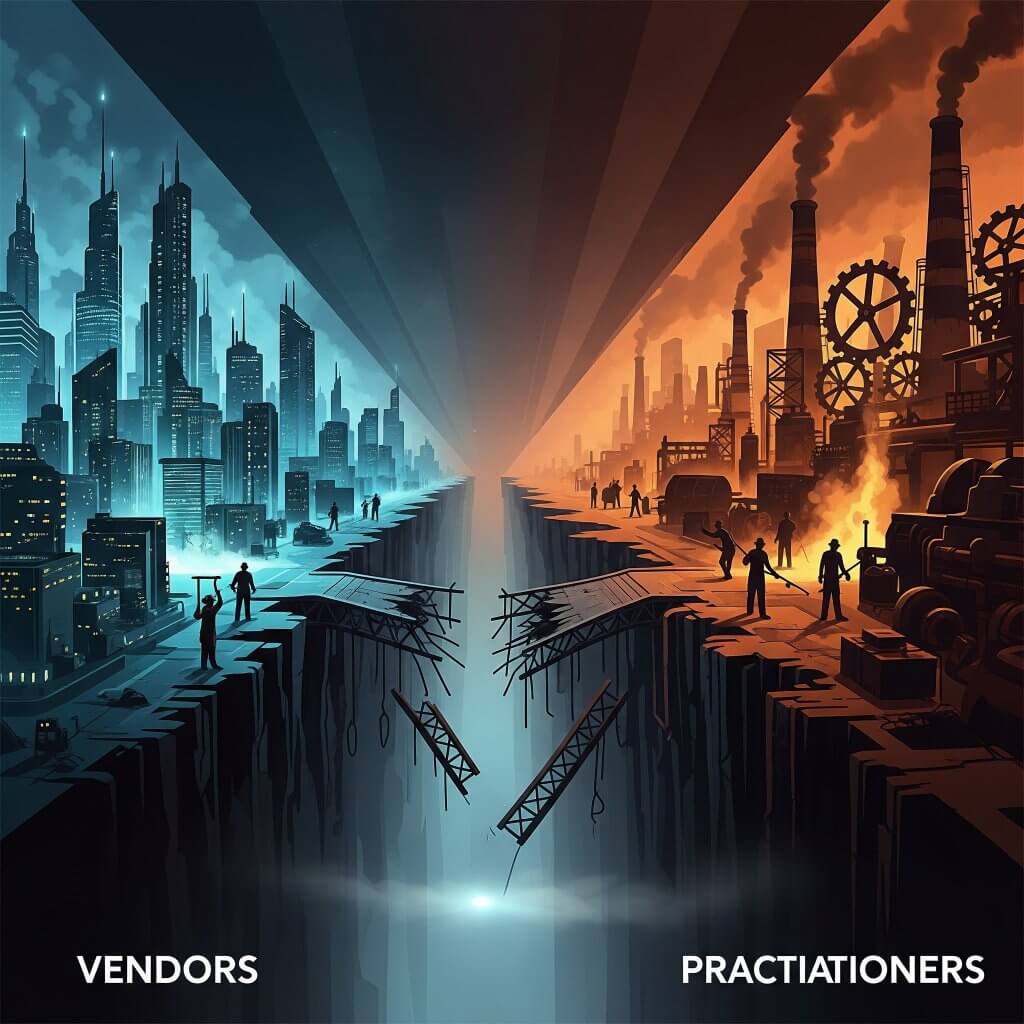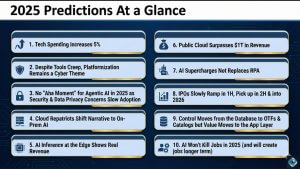I spend my days talking to CISOs, analysts, and engineers. I sit in on vendor briefings, read the latest industry reports, and, like many of you, I scroll through the forums where real practitioners share their uncensored frustrations. And a clear, frankly alarming, theme is emerging: a deep and widening disconnect between the cybersecurity solutions being sold and the realities of the teams on the ground.
Vendors are locked in a feature war, marketing a utopian vision of automated, AI-driven security with bells, whistles, knobs, and switches. Meanwhile, practitioners are drowning in a sea of “solutions” that often create more problems than they solve. They’re battling clunky user interfaces, fighting for budget to implement frameworks sold as turnkey products, and growing more cynical by the day.
This isn’t just a messaging problem; it’s a fundamental breakdown in the vendor-customer relationship. It’s a vendor blind spot of massive proportions, and it’s creating an opportunity for significant disruption. To survive, vendors must overhaul their entire business model, shifting from product-led feature showcases to outcome-driven, advisory partnerships.

The Feature Fallacy:
Selling What You Built, Not What They Need
This disconnect often starts in product marketing. Teams that spend years developing a product are naturally inclined to focus on what they believe makes it special: the features, the proprietary algorithms, the technical differentiators. They build their messaging around what the product is, not what it does for the customer.
This is a classic feature fallacy, and it’s a recipe for alienating modern buyers. As one user on Reddit vented while discussing compliance tools, the focus is often on “security theater,” optimizing for what looks good in a PDF rather than what actually secures systems. This practitioner was furious after being told by a consultant that auditors prefer “manual screenshots for authenticity” over real-time data from an API. The vendor and its partners were selling the feature (“screenshot evidence”), while the customer desperately needed the outcome (verifiable, continuous security).
This frustration is especially acute among Millennial and Gen Z buyers, who now make up a significant portion of the tech workforce. Unlike previous generations who may have been more tolerant of complex, feature-heavy software, these digital natives prioritize outcomes and experiences. They expect technology to be intuitive and effective, and they have little patience for solutions that aren’t. Their purchasing decisions are shaped less by a vendor’s datasheet and more by peer reviews and demonstrable value.
The User Experience Imperative: Why Has No One Built a SIEM People Love?
For years, security tools have gotten a pass for having poor user interfaces. They were complex tools for complex jobs, and the expectation was that the user would simply learn to navigate the labyrinth. Those days are over.
In a world where consumer technology has set a high bar for design, security practitioners are growing intolerant of clunky, unintuitive tools that hinder their ability to work effectively. Just ask a simple question in any security forum: why don’t people feel passionate about their SIEM? Many criticisms center on how poorly the user experience aligns with the urgent, high-stakes work analysts must perform.
This isn’t a minor grievance; it’s a critical operational issue. A poorly designed interface slows down incident response, increases the cognitive load on already-stressed analysts, and leads to missed threats. This user experience gap is a massive vulnerability for incumbent vendors. As legacy platforms continue to bolt on new features, they often become bloated and unwieldy, a “Franken-platform” of disparate interfaces.
This creates a prime opportunity for younger, design-centric companies to enter the market. A startup that builds a security tool that people don’t hate using has an immediate and significant competitive advantage. For the next generation of security leaders, a good user experience isn’t a “nice to have”; it’s a core requirement. Vendors who ignore this do so at their peril.
Selling a Journey, Not a Product: The Zero Trust Fallacy
Perhaps the most damaging disconnect is marketing complex, architectural shifts as simple, off-the-shelf solutions. Zero Trust is the poster child for this problem.
Vendors sell “Zero Trust solutions” as if they are a firewall, a product you can buy and deploy. But as any practitioner who has attempted it knows, Zero Trust is not a product; it’s a multi-year journey requiring a strategic roadmap, cross-departmental buy-in, and a significant commitment of time and resources.
Security forums are filled with professionals questioning the reality of it all. As one user asked, “Who here is actually implementing Zero Trust in a meaningful way?”, expressing a common sentiment that it’s often just a “buzzword” used to “look strategic.” This is the direct result of vendor marketing that oversimplifies a complex process.
When a vendor sells a “Zero Trust product” without setting the expectation of a long-term journey, they set their customers up for failure. The customer, expecting a quick fix, doesn’t allocate the necessary budget or personnel. When the promised “solution” doesn’t materialize, the project is deemed a failure, and the customer is left feeling misled and cynical. This not only damages the vendor’s reputation but also poisons the well for future security initiatives.
To be clear, this isn’t unique to Zero Trust. Many vendors are selling some version of “see everything, control everything, secure everything with one click***” and the level of cynicism around the one-size-fits-who-again? is palpable.

The AI-Fueled Sales Bombardment:
More Outreach, Less Connection
This transactional mindset has spawned its own monster: the relentless, AI-powered sales and marketing machine. Practitioners are buried under an avalanche of templated LinkedIn messages and cold emails. The irony is that AI, a tool with the potential for incredible personalization, is being used to create the most impersonal, trust-eroding outreach imaginable.
This isn’t just annoying; it’s creating severe sales fatigue. Every generic message that starts with “I saw your title…” chips away at a vendor’s credibility. For Millennial and Gen Z professionals, who grew up online and value authenticity, this approach is particularly alienating. They prefer collaboration over top-down directives and are quick to disengage from relationships that feel transactional.
To become trusted advisors, vendors must rein in these untamed AI engines. They need to shift from a high-volume, low-impact model to one that prioritizes genuine connection. This means that vendors must also learn to work together. No single product solves a CISO’s problems, yet vendors rarely collaborate. A customer’s environment is an ecosystem, and a vendor who can’t play well with others isn’t a partner; they’re just another silo creating more work.

The Way Forward:
From Transactional Vendors to Advisory Partners
To bridge this chasm of trust, cybersecurity vendors need to fundamentally rethink their approach. The old model of pushing features, closing a deal, and moving on is no longer sustainable in a market defined by subscription services, high churn rates, and a generation of buyers who value relationships over transactions.
The future is advisory. It’s about building long-term partnerships focused on customer outcomes. This requires a seismic shift:
From Product-Led to Problem-Led Marketing: Lead with a deep understanding of your customers’ problems. Your content should offer genuine insights and guidance, not just feature lists.
From Demos to Workshops: The sales process must become a collaborative strategy session. Act as a consultant, helping customers develop a realistic roadmap for achieving their security goals.
From Silos to Ecosystems: Acknowledge that you are one piece of a larger puzzle. Build strong integrations and partnerships with other vendors. Demonstrate how your solution works within the customer’s entire stack, not just in a vacuum. Your willingness to collaborate is a direct measure of your commitment to the customer’s success.
From Closing Deals to Ensuring Success: Customer success can’t be a post-sales afterthought. It must be integrated into the entire lifecycle, ensuring customers are not just buying a product but are successfully adopting it and achieving their desired outcomes.
Realigning Compensation: This is the hardest, but most critical, piece. Sales plans that heavily incentivize landing massive, initial contracts encourage the wrong behaviors. Explore models that reward customer retention, successful adoption, and long-term value creation. Tie compensation to customer health scores, renewals, and expansion.
This is a hard pivot, especially for large companies beholden to quarterly earnings. But in an uncertain market, skittish customers will be looking for partners they can trust, not just vendors looking to make a sale.
The security professionals in the trenches are sending a clear signal. They are tired of the hype, the complexity, and the broken promises. The vendors who listen—who focus on outcomes over features, on partnership over transactions, and on collaboration over competition—will be the ones who not only survive but thrive in the next era of cybersecurity.



